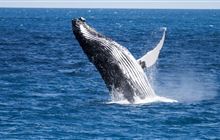Perano Whaling Station
Introduction
This site is closed due to unsafe overhead hazards.Perano Whaling Station closed
All buildings and concrete areas with poles and beams are closed. Follow all signage and stay out of the barriered areas.
The toilet is still accessible.
Perano Whaling Station is nestled in the secluded Fishermans Bay facing Kura-te-au/Tory Channel. It operated from 1911 to 1964, the longest of any 20th century whale oil processing plant in the country.
Many of the innovations that advanced whaling around the world were developed and tested in the calm waters of the station, such as the power-driven chaser boat and electric harpoon.
Image gallery
-
Whaling ship Tuatea returning with whales, Tory Channel, 1948. Ref: PAColl-8163-55. Alexander Turnbull Library. Image: Sanders Photo Studio | Creative Commons
![A view of buildings and wharfs with steep hills behind from the prow of a boat. A view of buildings and wharfs with steep hills behind from the prow of a boat.]()
-
Whale meat macerator, Perano Whaling Station Image: Herb Christophers ©
![Rusting tank and a giant mechanical gear mounted on concrete. Rusting tank and a giant mechanical gear mounted on concrete.]()
-
Veteran whale watchers Ted Perano, John Norton and others in the observation platform, part of the Whale Observer Programme looking at humpback migration, East Head Arapawa Island, July 2011. Image: Herb Christophers ©
![A group of people look through binoculars over a calm sea. A group of people look through binoculars over a calm sea.]()
The site was restored in 2010 by DOC and the remains of the massive processing complex are clearly visible, as well as the wharf the Perano chaser boats set off from. Surfacing from the clear blue water is the slipway, once used to haul 15 metre long harpooned whales. The site also features bone saws, a steam boiler, whale oil tanks, and the digester that was used to separate the oil.
The heritage of many New Zealanders, both Māori and non-Māori, can be traced back to the families employed by the Perano Whaling Station.
In the adjacent bay at Te Awaiti, less than 1 km from Perano Whaling station, was New Zealand's first onshore whaling station, established in 1829. Together, these locations are essential to understanding the history of whaling in New Zealand.
Getting there
Perano Whaling Station is accessible by boat landing at Fishermans Bay, either privately or with a commercial provider. Boating tours specific to the heritage of the site are sometimes held on significant anniversaries.
Ferries between Picton and Wellington pass directly by Fishermans Bay and you can see the whaling station’s remains as you cruise past.
Know before you go
Water safety
If you plan to enjoy the water, learn how to stay safe when swimming, boating and fishing.
A captain of industry
In 1904, Italian trader Joseph Perano was fishing when two humpback whales rose beside him, knocking the oars from his hands. Coastal trade had been slowing down, so Jospeh took this as a sign to focus on whale oil.
The Perano family began whaling in the Tory Channel in 1911, but later relocated to Tipi Bay.
Joseph and his brother Charlie split the business in 1924, and Joseph built the Perano Whaling Station in Fishermans Bay. By 1928, Joseph had enough success to absorb Charlie’s whaling station and devoted the Perano whaling operation to advancement, bringing in spotter aircraft, bomb harpoons, radio and improving processing infrastructure.
The last hurrah
Trevor Norton harpooned the last oil whale killed in New Zealand waters for Perano Whaling Station on 21 December 1964. The station announced its closure on 4 January 1965 as humpback numbers dropped and international competition increased.
In 2004, nearly forty years after whaling ceased, DOC started a survey to assess humpback whale recovery. For over a decade, in June and July each year, the trained eyes of old whalers returned to spot the animals they once hunted, to monitor their repopulation.




